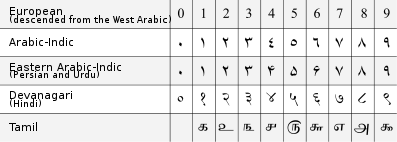 |
This is a file from the Wikimedia Commons. Information from its description page there is shown below.
Commons is a freely licensed media file repository. You can help.
|
Summary
| Description |
„Arabic Numerals“: English version. Comparison between five different styles of writing Arabic numerals. The terms ("European", "Arabic-Indic", etc.) are written in Arial Unicode MS and still are changeable. The numerals are converted into paths.
The Arabic numeral system has used many different sets of symbols. These symbol sets can be divided into two main families — namely the West Arabic numerals, and the East Arabic numerals. East Arabic numerals — which were developed primarily in what is now Iraq — are shown in the table below as Arabic-Indic. East Arabic-Indic is a variety of East Arabic numerals. West Arabic numerals — which were developed in al-Andalus and the Maghreb — are shown in the table, labelled European. (There are two typographic styles for rendering European numerals, known as lining figures and text figures). |
| Date |
6 January 2006 |
| Source |
Own work |
| Author |
Madden |
Permission
( Reusing this file) |
GFDL
|
Licensing
 |
Permission is granted to copy, distribute and/or modify this document under the terms of the GNU Free Documentation License, Version 1.2 or any later version published by the Free Software Foundation; with no Invariant Sections, no Front-Cover Texts, and no Back-Cover Texts. A copy of the license is included in the section entitled GNU Free Documentation License. http://www.gnu.org/copyleft/fdl.htmlGFDLGNU Free Documentation Licensetruetrue
|
File usage
The following pages on Schools Wikipedia link to this image (list may be incomplete):
This file contains additional information, probably added from the digital camera or scanner used to create or digitize it. If the file has been modified from its original state, some details may not fully reflect the modified file.
Learning is fun and easy with Schools Wikipedia. SOS Childrens Villages believes education is an important part of a child's life. That's why we ensure they receive nursery care as well as high-quality primary and secondary education. When they leave school, we support the children in our care as they progress to vocational training or higher education. There are many ways to help with SOS Childrens Villages.




